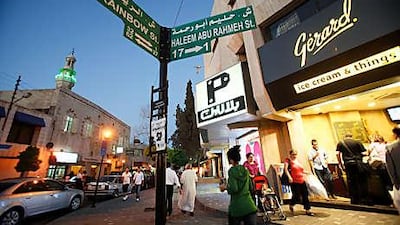AMMAN // Until a few years ago, residents of Jordan's capital would have to look out for well-known shops and landmarks when searching for an address. Street names and building numbers were all but invisible throughout most of the city.
That changed - somewhat - in 2007 when the Greater Amman Municipality introduced an address system. But while most residents say the system has been helpful, the culture of looking for familiar places first - be they restaurants, pharmacies, mosques or even the number of speed bumps on a road - remains. Rana Lahleh, a mother of three, said: "I think it [the new system] is great and I can find addresses easier. But of course I will always need to know the closest landmark or bank per se before the street's name.
"When it comes to giving people directions, it is not a problem to find my address since I live on a main street, but definitely the building's number made it simpler, since I don't have to tell friends to count the buildings." In 2007, the municipal authority started numbering buildings in a prominent blue, and a year later installed signposts on the pavements featuring street names both in Arabic and English. Though many streets had names before, they were featured on metal plates placed on walls that were difficult, sometimes impossible, to see.
Abdel Raziq Abu Sa'da, head of the naming and numbering department at the municipal authority, said: "Now 80 per cent of Amman's streets and buildings have a name and a number. We wanted to spread a culture of giving out addresses properly, which was absent from society. So far the feedback from citizens is positive. "At least when calling the civil defence to report a fire or an ambulance, one can give the street name and building including the area."
Businesses used to put up large billboards and posters on walls, buildings and electricity poles that people could use to identify different locations. Many, including officials at the municipal authority, complained that this was a form of "visual pollution" and are glad that the naming and numbering system is putting an end to the practice. Amman, a city that rolls over seven hills, is expanding. Until 2006, it encompassed 21 districts over an area of 747 square kilometres, but now it has 27 districts in an area of 1,700 sq km.
"While new streets open and new buildings are built, naming streets and numbering buildings is an ongoing process," said Mr Abu Sa'da. In the last two years 10,000 metal signposts have been installed. However, observers say it will take time for residents to familiarise themselves with the new system. Hussein al Khozahe, a sociologist and expert in developmental studies at the Al Balqa Applied University in Amman, said: "Inheriting the street names from generation to generation is difficult to implement immediately.
"Citizens apparently do not appreciate the new system yet. We also do not have a culture of maps. It takes time to change behaviour, we need at least 10 years from now." But critics say another reason people are not yet using the street names is because the municipality has yet to put up maps with the names. Nahed Abu Hadba, a supervisor at a telecommunications company and mother of three, said the name of her street is the last thing she gives when directing people to her home.
"Each time I give a friend the address, I still have to mention the name of the supermarket on the main street and a video store off the main street before I tell them to take the first turn on the left," she said. "People are still not familiar with street names and numbers, and when I mention the area and the street's name and the building number, how are they supposed to know? There are no maps or even billboard maps."
One commentator called on the municipal authority to put up signposts mapping streets around the city and also print out maps and distribute them for free. "Citizens appreciate the enormous efforts exerted by the Greater Amman Municipality," Ahmad Shaker wrote in the local daily Addustour this month. "But people struggle to find the name of the street or the building's number ? there needs to be large signs with street names and building numbers because it is [not easy] for people to look for them in corners and intersections.
"GAM is also required to place large maps in each area and in the most important locations," he wrote. For its part, the the Greater Amman Municipality said it is going to update its tourist maps that were last updated in 2005. The new maps are also being developed electronically. smaayeh@thenaional.ae

